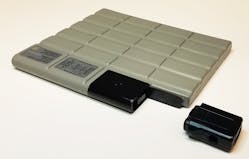Download this article as a .PDF
Tactical communications can make the difference between a successful mission and empty time spent in the field. The radio technology certainly supports in-field tactical communications, with manpack radios that are almost as rugged as weapons. But for extended missions, powering these radios can be a challenge.
For that reason, Inventus Power developed the CWB 150 FlexPack, a wearable battery pack that was designed to be carried into the field. It provides a large degree of flexure in both its horizontal and vertical axes. The conformal wearable battery (CWB) is completely safe for the battlefield. It can even be worn under water without fear of discharge or damage to the wearer.
For the infantry, bringing enough power to energize the modern military electronics pack can be a daunting task—one even more challenging than the mission at hand. In most cases, it can be likened to strapping a car battery on the back and heading out with a pack full of equipment. The CWB 150 FlexPack brings the equivalent or more energy than a car battery, in a flexible pack weighing only 2.6 lb. (1179 g). It has a nominal voltage of 14.8 V, with a full voltage range of 10.0 to 16.6 V dc.
The flexible battery pack is based on lithium-ion (Li-ion) chemistry with nominal capacity of 10 Ah and total energy of 148 Wh. It can be go through 500 charging cycles with no memory effect, to achieve within 80% of its original charged capacity. It is rated for maximum continuous discharge of 5 A.
The flexible battery pack can recharge at temperatures as low as −20ºC
(from −20 to +55ºC) and it provides three levels of charge/discharge safety protection. It meets electromagnetic-interference (EMI) standards for MIL-STD-461 and the battery pack can be safely immersed under 1 m of water for two hours according to MIL-STD-819G/Method 512.4. The battery pack employs an SMBus v1.1 communications bus for sharing data and communications with other electronic devices and systems, and is designed for operating temperatures from −30 to +60ºC.
“Our CWB products provide soldiers with a safer, ergonomic, centralized power solution that reduces weight and the overall number of batteries needed for a mission,” said Jeff Helm, Inventus Power’s business development manager. “Soldiers can rely on power for up to 72 hours without having to recharge or replace battery packs.”
The P-CWB battery pack is based on lithium manganese dioxide (LiMnO2) chemistry and provides an output voltage of nominally 15 V. It has power capacity of greater than 195 Wh, and meets all the safety requirements of MIL-PRF-32271 in a much more ergonomic form factor compared to traditional battery packs. The command module monitors and controls battery discharging, voltage output, and current output.
The CWB 150 FlexPack is one example of the technology developed by Inventus Power for the battlefield. The firm was recently awarded Patent No. 9,564,761-B2 by the U.S. Patent Office for complementary non-chargeable battery technology to the CWB 150 FlexPack: a Primary Conformable Wearable Battery (P-CWB) with removable command module (see photo). The power pack was developed in partnership with the U.S. Army.
As the modern soldier takes to the field, the assortment of electronic devices for surveillance, positioning, and communications increases, along with it the need for primary and secondary power. These innovative, flexible power packs literally become part of a soldier’s armor, eliminating the need to carry additional, heavy battery packs.
Inventus Power, 1200 International Pkwy., Woodridge, IL 60517; (630) 410-7900, (877) 423-4242


